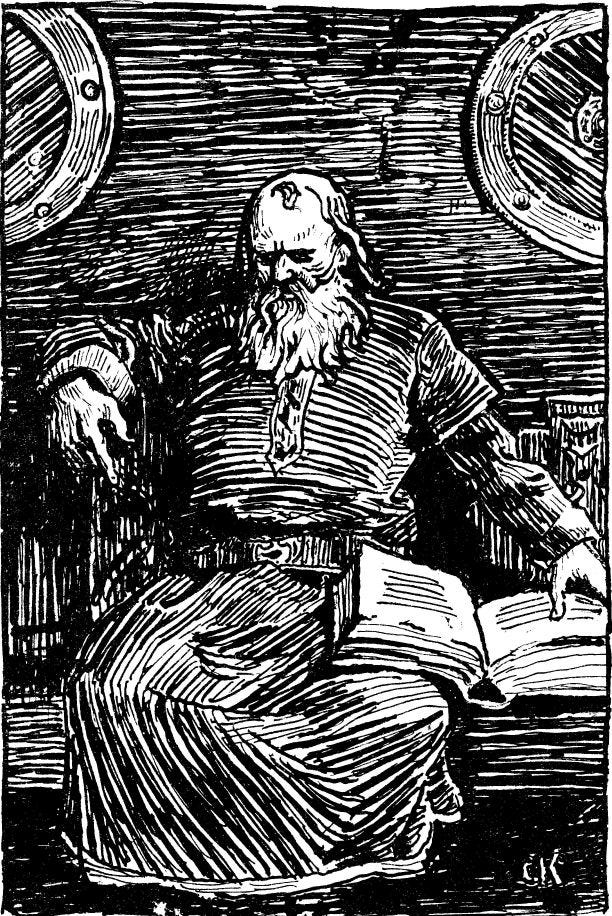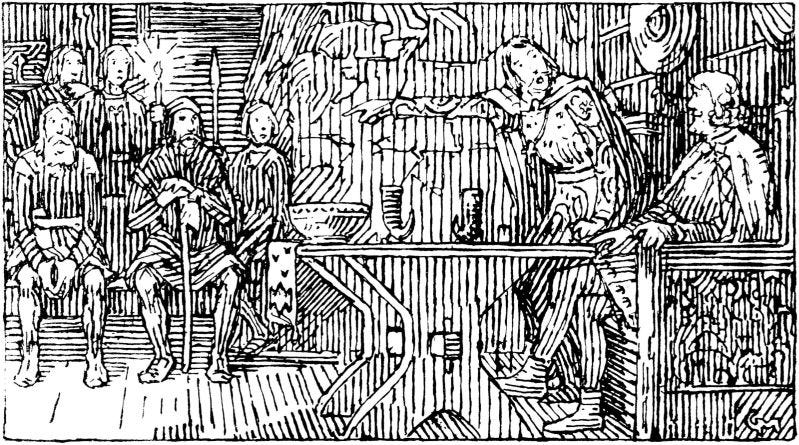Our recent essay on the work of the mind in the age of intelligent machines observes the contemporary dissolution of authorship and heralds its complete future obsolescence. We could also have said, dilution: the human paternity content of creations or operations traditionally ascribed to the mind is waning, at the same time as the proportion of those still bearing some human pedigree is being dwarfed by the immense influx of their artificial counterparts.
But what about authorship in the Middle Ages, and more specifically, for our purposes, in the Nordic Middle Ages? Heimskringla, John Megaard reminds us, has an exceptional status: indeed, it is inseparable from the name of Snorri Sturluson, while, otherwise, “the great saga literature has almost always been handed down without an author's name, and in cases where an author's name is found, it often belongs to a person whom we know little about.” (Megaard, 2017, p.18-19) John Megaard, philologist and specialist in Icelandic sagas, gives his remarkable essay tracking down these medieval authors a paradoxical title: Hvem skapte Heimskringla? i.e., Who created Heimskringla? It is the basics of his method that interest us today, but let's return for a moment to the question of authorship in Snorri's time.
We need to think back to the conditions in which the written word was produced and disseminated before Gutenberg. The term “author” and, in today's society, the intellectual property rights associated with it, are only valid when, firstly, the works are clearly delineated and, secondly, they can be published, i.e. made amply accessible to the public.
The manual work of writing was tedious, akin to the trade, that of a carpenter or goldsmith, and hence the book itself a precious object. The works of Snorri's time are handed down by a number of transcribers likely to leave their mark in different ways: at their discretion, to shorten, or to append or to replace words or expressions in the interests of clarity. So much so that some scholars, most notably Iceland's Sigurður Nordal, argue that the idea should be abandoned of ascribing sagas texts to authors on language grounds. This opinion has kept the debate on the authorship of sagas at bay for some time.
Beyond transcription, it is also editing, particularly by historians, that blurs the boundaries of works. Since antiquity, it has been common for them to extend a work that already had several contributors. Here, The saga of Sverre is highly representative. Primarily edited by Abbot Karl Jonsson, its original story seems to have been written by two residents of the same cloister, and its prologue mentions two other contributors to the publication. (Megaard, 2017, p.24-25)
The question of publicity, for its part, ties in with that of the works' destination. Here, Holzknecht’s work on Literary Patronage in the Middle Ages is illuminating. He describes the progressive emergence of authorship, already observed in societies before Biblical times. “There had been first of all a communal period of cooperative effort in which individual ownership gradually developed as the literary individual emerged from the throng.” Recognition of a literary profession confronts authors with the prevailing economic conditions, while recognition of literary distinction awakens them to their market potential. For remuneration, “it is to individuals that the poet must look”. Then, it is “only when the author perceives that his poetry is a ware which may possibly be sold, and decides […] to court an individual with it, that the real sense of literary property develops and patronage as a source of compensation comes into being”. This emergence movement is not unidirectional across the ages. In the troublous times of the early Middle Ages, “the high individualism of Empire slipped back into an almost communal condition”, from which a slow, “gradual regrowth of the conditions of classical times" operates. The latter was catalyzed by the rise of the highly modern “ideas of fame, of glory, of individual achievement, literary property and individual worth”, which characterize the Renaissance.
Patronage, ultimately, “is the employment”, regardless of its motives, “of favor, protection and influential support to advance the interests of art”, particularly by subsidizing authors. It almost always implies, as the name suggests, “something of the relation of superior to inferior which existed between a powerful Roman patron and his clients”. A highly inegalitarian distribution of wealth makes it a necessity; "patronage, Holzknecht tells us, flourished best in a highly aristocratic form of society", and "in this respect, medieval society was ideal". Although “sporadic and uncertain”, and of a magnitude incomparable with that of the Renaissance, medieval patronage was the province of kings and emperors, driven often by a fondness for literature: mécénat became a fashion. (Holzknecht, 1923, p.2-3; p.55-56)

Authors of the Nordic Middle Ages, Megaard tells us, write for “very specific addressees”: their works of art are “in the recipient's honor”. This is clearly demonstrated in poetry: the skald 's undying attentiveness to the king or patron from whom he can expect a reward, expresses itself in panegyric of the latter or detraction of his enemies. Such is the case of the poet Snorri, in Håttatal, a tribute poem to Håkon Håkonsson and Duke Skule. Another saga, Sturla Tordsson's about Håkon Håkonsson, serves as a source and corroboration: we learn that Duke Skule commissioned Snorri to compose a poem disparaging a court man, Gaut Jonsson, alleged to have ruined Skule's friendship with the king. (Megaard, 2017, p.38-39)
Megaard's precise aim is to demonstrate that the prose of sagas, like the poetry of skalds, exhibits what he calls tendencies (tendens): evidence, running through the texts, of some kind of partisanship. These tendencies then serve as ideal tools for the philologist seeking to establish authorship.
Our Saga chronicles series is precisely interested in the genesis of works from ancient Icelandic times: both history and literature. John Megaard, whose method we shall examine shortly, is an important guest here.
This method is applied, in his book, to the unraveling of the mystery surrounding Heimskringla, a work yet commonly referred to, as if its author were unequivocal, as Snorri's Kings' Sagas (Snorres kongesagaer). The scholar Lars Lönnroth seems to have been the first, in 1965, to cast doubt on Snorri's authorship of both the Edda and Heimskringla. He demonstrates that the authors of the sagas, important intellectuals, were commissioned by heads of state, and reexamines Snorri's role as either author or compiler. (Lönnroth, 1965)
Several troubling elements around Snorri’s Edda fuel these suspicions. All the manuscripts differ from one another, with only Coxed Trajectinus not adding to the three parts evoked in the introduction. This introduction, in its Uppsala version, is both precious and ambiguous. It says
Bók þessi heitir Edda. Hana hefir saman setta Snorri Sturlu sonr eftir þeim hætti, sem hér er skipat. Er fyrst frá ásum ok Ymi, þar næst Skáldskaparmál ok heiti margra hluta, síðast Háttatal, er Snorri hefir ort um Hákon konung ok Skúla hertoga.
“This book is called Edda. Snorri Sturluson has compiled it in the manner arranged here. First it tells of the Æsir and Ymir, then Skáldskaparmál (the language of poetry) and names of many things, finally Háttatal which Snorri has composed about King Hákon and Duke Skúli.”
Snorri wrote Håttatal, and we can draw no conclusions about his authorship of the other two parts. How should “has compiled” be interpreted? Another source, the medieval Icelandic manuscript Oddaverjaannáll, reiterates: “Han satte sammen Edda og mange andre lærde bøket [og] islandske sagaer.” Megaard explains:
On the one hand, the juxtaposition of "Edda" and "many learned books" could give reason to interpret "put together" as "translate", "organize", "collect". But this is less appropriate for “Icelandic sagas”, where the meaning “to author” can appear quite natural, at least by our standards.
Manuscript variability is perhaps what prompts the author of this preamble to specify his version faithful to Snorri's original: "Snorri Sturluson has compiled it in the manner arranged here". (Megaard, 2017, p.250-251)
As the authorship of works, even those most assertively attributed by philological tradition, comes into question, investigations begin. John Megaard’s method postulates that tendencies, i.e. marks of partisanship, pervade the texts.
For an example of the tendencies at work in the Heimskringla, we can turn to two consecutive sagas: The saga of King Magnús Barefoot, followed by that of his three sons, The Saga of Sigurðr the Jerusalem-farer, Eysteinn and Óláfr. The study of those tendencies points Megaard towards an attribution to Are Frode, the better-attested author of Íslendingabók, which we have perused many times.

Here are his conclusions.
Are [...] synes å ta parti for Magnus Berrføtts motstandere i kampen om tronen, samtidig som de har sympati for de han slåss mot på hærtogene utenfor Norges grenser.
“Are [whom Megaard assumes have written or contributed to the Saga] [...] seem to side with Magnús Barefoot's opponents in the battle for the throne, while at the same time having sympathy for those he fights against on army campaigns outside Norway's borders.”
Subsequently, Sigurðr the Jerusalem-bearer and Eysteinn, Magnús Barefoot's successors to the throne, are described by the presumed author as pursuing widely diverging foreign policies in Northern and Southern Norway, over which they respectively reigned. The relationship to Sweden is particularly telling. Eysteinn strengthens ties with Magnús Barefoot's former opponent through marriage. Sigurðr allies himself with the Danish crown, and immediately after his brother's death, calls for an offensive against Sweden.
What follows is particularly illuminating about the John Megaard method. On Eysteinn's death, a new royal pretender (kongsemne) is put forward to succeed him. As the saga depicts it, Sigurðr has no choice but to give in:
Fortellingen […] i Heimskringla tyder på at det nye kongsemnet har hatt sterke støttespillere, siden Sigurd Jorsalfar måtte gi etter og godkjenne slekskapet.
“The story [...] in Heimskringla suggests that the new royal pretender had strong supporters, since Sigurd Jorsalfar had to give in and approve the kinship.”
The royal pretender, Harald Gille, would reign over half of Norway from the time of Sigurd's death, before definitively defeating his rival Magnus Blinde four and a half years later. Our author, Megaard says, presents the events as a victory for Eysteinn's party, allied with the Swedes, over that of Sigurd Jorsalfar, allied with the Danish crown. The tendencies are reflected in the choice of semantics, whether laudatory or disparaging, but above all in the choice of an angle of view (synsvinkel). Are Frode's successors, he concludes, will present the history of kings differently. (Megaard, 2017, p.213-215)
However, the collection of clues is not limited to bias. As we have seen, Megaard also summons the manuscripts. Another crucial aspect of his method comes into play here: to each of the five authors screened as potential contributors to Heimskringla, at least one text can be attributed with certainty, providing a solid foundation for meaningful analysis. So, the work most solidly attached to Are Frode is his Íslendingabók - it opens, as we read earlier, with an account of its sources, the author's ancestors, who coincide well with Are's. We have information about the identity of the pretenders to authorship Isleiv, Sæmund, and Are. While information about Eirik Oddsson is scarce, his authorship of Hryggjarstykki is well documented. Certainty about both reference works and subsequent attributions emerges indeed from confronting documents: manuscripts, secondary literature, author information, the intersections of history and biography.
Finally, Megaard does not disregard literary evidence, finding striking similarities between seemingly distant works. Among these are stylistic features - in Are Frode's case, a distinctive way of introducing word synonyms. Or the way the text is interrupted to showcase the verses of the skalds, who we have seen clearly composed to the glory of kings.
Ultimately, John Megaard's investigations serve the purpose of “dating Old Norse prose literature” (Megaard, 2017, p.42)
[…] ut fra et ønske om å bidra til dateringen av den norrøne prosalitteraturen.
and generally shedding light on the texts’ genesis, for two ends. First, to examine the value of the sagas as historical sources, regarding the history of kings, the portrait of society both from the time of the narrated history and from the time of writing. Secondly, for the sake of philology and to reconstruct the genre's history.
We said above
The term “author” and, in today's society, the intellectual property rights associated with it, are only valid when, firstly, the works are clearly delineated and, secondly, they can be published, i.e. made amply accessible to the public.
This delimitation is blurred by our increasingly inevitable and inextricable intermingling at work with intelligent machines; access to publication, meanwhile, is threatened by its excess. Overproduction by ever more educated masses, instantaneous, ubiquitous and fluid internet distribution, asymptotically induce perfect deafness: the paroxysmal possibility of addressing absent subscribers. The man of the future will be much less sensitive to the concept of authorship than the John Megaard of early 21st century. He will be like the troubadour or minstrel of ancient communal times, wholeheartedly dropping a handcrafted trickle into the ocean of machine words.
References
Megaard, J. (2017). Hvem skapte Heimskringla?: forfatterne bak Snorres kongesagaer. Solum Bokvennen.
Holzknecht, K. J. (1923). Literary Patronage in the Middle Ages. University of Pennsylvania.
Lönnroth, L. (1965). European Sources of Icelandic Saga-Writing: An Essay Based on Previous Studies. Thule





